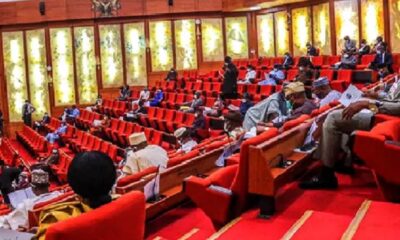Opinion
Botched 5G services and the Wi-Fi 6 gamble

By Sonny Aragba-Akpore
When fully implemented,Fifth Generation (5G) technology and services will transform the telecommunications landscape in Nigeria like nothing else before it,Isa Pantami,the immediate past Communications and Digital Economy Minister boasted on the eve of the 5G auction three years ago.He spoke with certainty and confidence.
And like in a relay race,the Chief Executive of the Nigerian Communications Commission (NCC),Umar Garba Danbatta took the baton and began the spirited advocacy building frenzied hypes around the auction.
Pantami had allegedly misled President Mohammadu Buhari, the Federal Executive Council (FEC) and everyone else in the country to believe that 5G will provide life abundance with unbelievable internet speed like lightening.
The first auction saw MTN and Mafab Communications limited (a Special Purpose Vehicle) winning two available lots at a bid price of $273.6m each.
A little over a year later,Airtel Africa got a third lot thus completing the experimental triumvirate.
But that is where the story of 5G ends so much that even the people at NCC cannot in all sincerity beat their chests to say 5G exists and will gladly list it as part of their achievements.
If it exists at all,it is better imagined because nothing is being said about it either on earth or elsewhere.
5G networks are not visible.Perhaps it is available and in use by an insignificant fraction of the population.
Even the licence beneficiaries speak about it in subdued tones and perhaps see the investment like it’s often said in local parlance as “bad market “.
Elsewhere in Africa,some countries are in the race and even though they are yet to fully achieve meaningful milestones,there are strong indications that they are coasting home to victory in this race.Not yet in Nigeria.
The India example is exemplary.Perhaps,many countries should visit India and ask them how they were able to achieve the milestones especially in a country of over 1.428 billion population.
The Indian regulator created a workable template introducing a business model that allows beneficiaries of the bid to stagger license fees payments over a period of 10 years to enable them deploy services sensing that equipment and infrastructure for 5G is not a walk in the park.
And the operators appreciate that move.
But in Nigeria,the people who midwifed 5G did it to raise money for government and allegedly made some consultants smile to the bank after collecting their well appointed commissions.
And now neither the license beneficiaries nor the people they are supposed to serve have anything to show for all the troubles.
But while consumers are in a dilemma waiting for when the services will ever come,the NCC on September 19,2024 announced in Lagos another experiment if not a gamble.
It is introducing Wireless Fidelity (Wi-Fi 6) which they claim will bridge the digital divide whereby the speed of internet will be “amazing.”
Globally,Wi-Fi 6 is not new.It has taken root in parts of the world including the United States,(USA),South Korea,Canada,U.K and many others.
The International Telecommunications Union (ITU) created workable templates for it some of which the Federal Communications Commission (FCC) of the USA had adopted with a home grown modification.
So if Nigeria adopts it,the question is how prepared is the regulator in Abuja to manage it for the benefit of consumers.?Will it be another hype like we saw in 5G?
Speeches and more speeches were made on September 19,2024 in Lagos on the subject with a number of participants having their reservations if not misgivings.
When the NCC conducted the 5G
auction of two lots of 100 MHz slots of 3.5 GHz band for the deployment of 5G networks in
Nigeria it was done with funfare likened to bazaar of sorts.
Three companies participated in the auction process and the bidding commenced at $199.37m, as against the reserve price of $197.4m (75 billion naira) set by the NCC
After 11 rounds of bidding, the auction ended at $273.6m for each available lot with MTN Nigeria Communications Plc (MTN) and Mafab Communications Limited (Mafab) emerging as preferred bidders.
And the preferred bidders were
expected to pay the winning bid price, less the Intention-to-Bid Deposit, no later than February 24,2022.
MTN was to pay an additional sum of $15.9m to be assigned the preferred Lot One (3500-3600
MHz), while Mafab was assigned Lot Two (3700-3800 MHz), at no extra cost.
In addition, Mafab was required to acquire a Unified Access Service License, which is the operational license for the frequency spectrum at an additional fee of N374.6m (approximately $905,000 then).
The Information Memorandum (IM) provided for a validity period of 10 years for the awarded
spectrum and further requires licensees to roll out service in at least one state in each geo-political zone within the first two years from the effective date of the license. Further roll out was expected in six additional states in the 3rd and 5th years.
The technology is expected to have been fully deployed nationwide between the 6th and 10th year of the award of the license. Roll out in each state was expected to be a minimum of five sites per state.
The Federal Government earned $820.8 million from the auctioning of the 5G licence processes.
Pantami who said it was a game changer told President Muhammadu Buhari administration then that 5G will make a world of difference.
According to Pantami , in addition to the revenue generated from the 5G spectrum, revenue is being generated from other spectrum fees. “For example, in 2020, N26,428,642,451.61 was generated as spectrum fees.”
“MTN, Mafab and Airtel all have participated in the auction process and each obtained a lot of 100 MHz from the 3.5GHz spectrum after successfully participating in the auction process.The story has not gone beyond that.
Now another experiment,the Wi fi 6 which ITU says could be accessed on the 5925–7125 Megahertz (MHZ) band, and is designed to deliver optimized performance for next-generation use cases.
As with any wireless technology, Wi‑Fi depends on access to radio frequency spectrum. But a lack of spectrum threatens future Wi‑Fi performance and functionality.
“ Policymakers, recognizing this, are expanding Wi‑Fi spectrum access with a focus on the 5925–7125 megahertz (MHz), or 6 gigahertz (GHz), frequency band. Opening this band to Wi‑Fi will enable a wide range of new use cases,”ITU submits.
These — combined with expanded broadband access via fibre or satellite — promise to deliver versatile and extremely affordable connectivity. This makes Wi‑Fi an ideal force multiplier for connectivity.
ITU explains that the case for allowing Wi‑Fi services in the 5925–7125 MHz band is clear and compelling, with 6 GHz Wi‑Fi already delivering real socio-economic benefits in many countries.
“The diverse and growing product ecosystem for 6 GHz Wi‑Fi fits perfectly with broadband objectives in developed and developing countries — and without disrupting incumbent operations.”
Granting Wi‑Fi access to the 5925–7125 MHz band would be the best way to maximize the socio-economic value of this spectrum. Conversely, 6 GHz IMT “vaporware” looks far from achieving commercial feasibility, particularly given a total absence of equipment at this stage.”
The ITU says in Real-World Speed and practical real-world scenarios, WiFi 5 typically provides speeds ranging from 300 Megabit per second (Mbps) to 1.7 Gbps. “On the other hand, WiFi 6 can provide speeds ranging from 600 Mbps to 4.8 Gbps or more in real-world usage.”
According to ITU,”Wi-Fi 6 is the latest standard from the Wi-Fi Alliance based on the 802.11ax protocol, and provides critical capabilities needed for next generation enterprise requirements. “
Wi-Fi 6, also known as 802.11ax, is the latest generation and standard for wireless networking that replaces the 802.11ac, or Wi-Fi 5, standard. Prior to the release of Wi-Fi 6, Wi-Fi standards were identified by version numbers ranging from 802.11b to 802.11ac.
Wifi 6 is capable of connecting no fewer than eight devices simultaneously and creates a seamless connection to these devices at minimal costs.
Despite the beauty and robustness of Wi-Fi 6,there are drawbacks .
“If iPhone is older than the iPhone 11, it can’t use Wi-Fi 6. But there are other ways to make your phone’s internet run as fast as possible.
An older laptop won’t be able to take advantage of Wi-Fi 6 either. A Wi-Fi 6 router will still work with older devices, you just won’t enjoy all the benefits listed above.”ITU submits.
When he spoke at the NCC Yearly Stakeholders Consultative Forum on Emerging Technologies in Lagos last week,Executive Commissioner (Technical Services) Abraham Oshadami told his audience that “Wi-Fi-6 represents a significant leap in wireless technology. It offers an opportunity to support more devices with faster speed and greater reliability.” adding that “this is particularly strategic in a world increasingly dominated by the Internet of Things (IoT), where everything from smart homes to advanced industrial systems depends on robust wireless connectivity.”
Oshadami said that the deployment in the lower 6GHz band is not just about faster internet; “it’s about enabling the next generation of technological innovation and economic growth.”
Oshadami,with a measure of confidence went memory lane saying “throughout the last ITU Radiocommunications (ITU-R) Sector study cycle, experts discussed, amongst many other things, the use of Wi-Fi in the lower 6GHz Spectrum Band and made recommendations that were subsequently finalized at the 2023 World Radiocommunications Conference (WRC-23) where the 6GHz Spectrum Band was allocated for Wi-Fi and IMT applications.”
He said prior to the 2023 World Radiocommunications Conference, African Telecommunications Union (ATU) had already concluded its decision on the 6GHz Spectrum Band and recommended that administrations in Africa adopt the lower 6GHz for Wi-Fi-6 applications. “This decision was taken to WRC-23 and at the end of the day, Africa came out victorious. Having played a vital role in securing this spectrum for Wi-Fi deployment, it has become imperative to open the frequency for deployment of Wi-Fi Application.
However, as a world class organisation and in the spirit of participatory regulation, we cannot sit down in our offices and make unilateral decisions without the input of our stakeholders” hence the consultative forum on emerging technologies.
Although it is not clear when services on Wi-Fi 6 will flag off and modalities for licences to be issued or whether it will be an open market for all comers,there are strong indications that licensing may be very flexible especially with regards to assignment of the frequency to power the system.
But the question that is on the lips of service providers and the enthusiastic consumers is whether this will not go the way of 5G?
Time will tell.
Opinion
Hon. Prof Nnamchi’s Low Social Media Presence Doesn’t Define His Output- A Reply To X User’s Observation

By Titus Agbo
A user on X, formerly Twitter, named Mechelito@Onyema_7, claimed that Hon. Professor Paul Sunday Nnamchi, the member representing of Enugu East/Isi Uzo Federal Constituency in the House of Representatives doesn’t post about the insecurity issues in Eha-Amufu and his efforts to impact his constituents on his X handle, @sunday_nnamchi. The user supported his claim with a screenshot of Nnamchi’s X account page.
However, it’s worth noting that Professor Nnamchi’s low online presence doesn’t necessarily reflect his efforts and output. He was raised by Catholic priests and has a humble disposition. Before venturing into politics, he was involved in humanism, providing free computer training to students in his local government area, Enugu East. This initiative, which aims to expose students to information and communication technology (ICT) education, has trained over 2,000 students as he has since expanded it to accommodate his constituents from Isi Uzo immediately he was elected into the National Assembly.
# Key Achievements
-Scholarships*: Nnamchi has offered scholarships to hundreds of indigent students from various communities within the constituency, including non-indigenes residing in Enugu East/Isi Uzo. Sewed school uniforms for pupils in primary schools and facilitated employments for a few constituents.
– *Infrastructure Development*: He deployed ₦300 million worth of solar-powered streetlights to communities in Enugu East Local Government Area last year and plans to replicate same in Isi Uzo this 2025.
– *Education and Healthcare*: Nnamchi has built and renovated classroom blocks, provided medical outreach programs, and offered free medical treatments and medications to constituents who couldn’t afford them.
– *Security*: He raised a motion on the Eha-Amufu killings on the floor of the House of Representatives on the 19th December, 2023 prompting the House to urge the Inspector-General of Police and the Chief of Army Staff to deploy adequate security personnel to Eha-Amufu and also directed the National Emergency Management Agency, (NEMA) to provide relief materials to the affected victims.
Professor Nnamchi also issued a strongly worded press statement in December 2024 reminding the relevant security agencies of the need to step up their operations in Eha-Amufu. The motion and the subsequent press statement issued the following year when the hoodlums struck again in 2024 were widely reported by both online and major newspapers as can be observed with a few examples of the publications below.
– “Lawmakers Seek Urgent Action To Address Insecurity In Enugu State” by Gloria Essien, Abuja (Voice of Nigeria online, December 4, 2024)
– “Enugu attacks: Reps urge FG to intensify efforts against insecurity in S/E” (Vanguard Newspaper, December 4, 2024)
– “Task FG to address insecurity in South East” by Ndubisi Orji (Sun Newspaper, December 5, 2024).
Nnamchi has sponsored 36 establishment and amendment Bills and numerous motions as at March 2025. The Order Paper, an authoritative in-house journal of the National Assembly, adjudged him the most performing legislator from the Southeast in 2024 ¹.
I want to assure the above X user that all Hon Professor Nnamchi’s social media accounts will be put into proper use henceforth to keep constituents like him updated with Professor Nnamchi’s legislative and constituency engagements.
Titus Agbo, a public affairs analyst wrote from Enugu
Opinion
5G,IoT and AI to boost global GDP by 2030

By Sonny Aragba-Akpore
With Mobile technologies and services now generating around 5.8% of global Gross Domestic Product (GDP) a contribution that amounts to about $6.5 trillion of economic value, there are strong projections that by 2030, this figure will rise to almost $11 trillion, or 8.4% of GDP.
Global System of Mobile Communications Association (GSMA) says much of this will be driven by countries around the world increasingly benefiting from the improvements in productivity and efficiency brought about by the increased take-up of mobile services and digital technologies, including 5G, Internet of Things (IoT) and Artificial Intelligence (AI).
The GSMA recently introduced the 5G Connectivity Index to provide insights into 5G performance in 39 markets in order to encourage informed decision-making.
In terms of Economic Impact,
the GSMA emphasizes the economic benefits of mobile technologies and services, including 5G, projecting that they will contribute significantly to GDP growth by 2030.
“The GSMA provides specific reports and analyses on 5G in different regions, such as Sub-Saharan Africa, Asia ,Middle East among others highlighting the progress and challenges of 5G deployment in specific areas.”
In Sub Saharan Africa for instance with particular attention on Nigeria,South Africa,Egypt,Kenya and Botswana among others some measure of progress in deployment has been recorded.
The rollout of 5G has brought immense benefits across multiple industry sectors, particularly those involving internet of things (IoT) and artificial intelligence (AI) applications in which the real-time transfer of data is crucial.
More broadly, the adoption of 5G is expected to accompany increased data use across the globe, with forecasts anticipating mobile data traffic of over 300 exabytes per month by 2030, more than twice the volume consumed in 2024 according to Statista.
And with a third of global population expected to be covered by this fifth generation (5G) networks ,a technology that has defined new ways of communication by 2025 ,GSMA
says the technology has surpassed growth projections of all times.
“5G subscriptions increased by 163 million during the third quarter 2024 to total 2.1 billion. 5G subscriptions reached close to 2.3 billion by the end of 2024 accounting for more than 25 percent of all global mobile subscriptions.
“4G subscriptions continue to decline as subscribers migrate to 5G” according to GSMA.
As of the first quarter of 2024, there were nearly two billion 5G connections worldwide, with 185 million new additions. This is expected to grow to 7.7 billion by 2028.”
Statistics show that 5G is the fastest-growing mobile broadband technology, reaching 1.5 billion connections by the end of 2023.
It only took four years to reach this number, compared to 10 years for 3G and more than five years for 4G.
“5G is more than a new generation of technologies; it denotes a new era in which connectivity will become increasingly fluid and flexible.5G Networks will adapt to applications and performance will be tailored precisely to the needs of the user” GSMA submits.
By covering one-third of the world’s population , impact on the mobile industry and its customers will be profound according to GSMA.
To deepen the spread of 5G ,GSMA is working closely with the mobile operators pioneering 5G, “by engaging with governments, vertical industries including automotive, financial services, healthcare providers, transport operators, utilities and other industry sectors to develop business cases for 5G.”
And In order to accelerate the growth and spread, many operators are said to be deploying
AI technology as part of an integral part of telecoms operators’ strategic and operational plans.
“Operators are making important advancements in the deployment of AI technology, which is serving as a transformative force shaping the telecoms industry. By deploying autonomous AI-based systems, operators can enhance operational efficiency, customer satisfaction and security, while also creating new revenue opportunities”.
China, South Korea, the United Kingdom, Germany, and the United States are the leading countries with robust 5G coverage in the world.
Since the first commercial launches of the fifth generation of mobile networks in late 2018, these five countries have emerged as leaders because multiple companies in these countries have deployed networks and are selling compatible devices. Countries including Switzerland and Finland are up and comers in 5G development, though they have limited deployment.
In China there are three Companies leading in deployment.
The world’s largest 5G network was launched by the three largest Chinese network operators Oct 31, 2019, according to the state-run news agency Xinhua. These are China Mobile, China Unicom, and China Telecom which all activated their networks in less than five months after they were issued 5G licenses.
Each of the network operators offered their 5G services at $18 per month in 50 Chinese cities at the beginning of the launch.
GSMA expects 36% of China’s mobile users to be using 5G by 2025. That’s about 600 million subscribers, who would also make up 40% of the entire global 5G market by this year.
This is all despite efforts made by the United States government to hamper the progress of Chinese vendors, though those efforts may affect how Chinese companies may expand into the global market.
In South Korea,SK Telecom and Korea Telecom run as the main competitors for the South Korean 5G market.
SK Telecom acquired spectrum in the 3.5 GHz and 28 GHz frequencies to prepare for deploying 5G.
In April of 2019, the Enterprise claimed to be the first mobile carrier in the world to launch 5G services to work on 5G smartphones. SK Telecom asserted an edge over rival Verizon, as the former launched 5G services available at the same time as Samsung Galaxy S10 5G smartphone launched in South Korea. Verizon launched mobile 5G services in the U.S. before a 5G enabled smartphone was available to U.S. consumers.
SK Telecom also conducted tests with a 5G Standalone (SA) Core (a core not reliant on the 4G network) for their 5G network in cooperation with Samsung Electronics.
The world’s largest 5G network was launched by the three largest Chinese network operators Oct 31, 2019, according to the state-run news agency Xinhua. These are China Mobile, China Unicom, and China Telecom which all activated their networks in less than five months after they were issued 5G licenses. Each of the network operators offered their 5G services at $18 per month in 50 Chinese cities at the beginning of the launch.
“What we are seeing is a concerted effort by the Chinese — the operators, vendors, and government regulators — to deploy 5G as quickly as possible,” Chris Nicoll, principal analyst at ACG Research, pointed this out in a November 1, 2019 SDxCentral article.
With all of these players working together, the three network operators had collectively deployed nearly 86,000 5G base stations peaked over 130,000 by the end of 2019. The latter number breaks down into China Unicom and China telecom, with each planning to install 40,000 base stations, and the market leader China Mobile to install 50,000.This was the projection by 2019 but they have since overshot this by the beginning of 2024.
The International Telecommunication Union (ITU), says 5G coverage reached 40% of the world’s population in 2023 with an uneven coverage and distribution with developed countries having more coverage than low-income countries:
In Europe ,68% of the population is covered and
Americas had 59% of the population covered while
Asia-Pacific has 42% of the population covered as at 2023.
Arab States have 12% of the population covered.
Commonwealth Independent of States (CIS) had 8% of the population covered.
ITU figures show Africa,s coverage rose to 10 % of the population by 2023 .
The ITU also notes that 90% of the world’s population is covered by 4G, but 55% of people without access to 4G live in low-income countries because In low-income countries, 3G is often the only technology available to connect to the Internet.
The ITU develops and adopts international regulations and global standards to enable the harmonization and implementation of broadband mobile networks.
In Africa, around a dozen nations have launched services including Botswana, Kenya, Mauritius, Madagascar, Nigeria, Seychelles, South Africa, Tanzania, Togo, Zimbabwe, and Zambia but Africa is a patchwork of 54 countries.
And penetration is predicted to be slow.
By 2027, Ericsson predicts that 80 percent of phone users in Europe will have 5G service.
At the same time, 5G subscriptions in Africa, home to 1.4 billion people, May stagnate at a little over 10 percent. Why will so few people in Africa get access to 5G services?
China, South Korea, the United Kingdom, Germany, and the United States remain the leading countries with robust 5G coverage in the world.
While many countries are already providing robust services,Africa remains on the outskirts of 5G services.
The countries in Africa that have launched 5G networks, include South Africa with its roll out
In March 2022, when the Independent Communications Authority of South Africa (ICASA) sold spectrum across several bands.
In Nigeria,MTN rolled out commercial 5G services in Lagos in 2022, with other roll out in Abuja, Port Harcourt, Ibadan, Kano, Owerri, and Maiduguri among others.
MTN Congo announced that it was the first country in Central Africa to deploy 5G.
In Botswana Orange deployed 5G technology to provide new services in the Gaborone and Francistown regions.
Other countries in Africa that have launched 5G Fixed Wireless Access (FWA) services include: Angola, Kenya, Zambia, and Zimbabwe.
Analysts say “5G’s potential is growing due to its ability to deliver fiber-like speeds. However, there are still challenges in the region, such as:
Urban areas are reaching their maximum capacity whereas a large portion of the population lives in rural areas.
This explains why 5G adoption in the sub-Saharan region is currently below six percent “
Analysts report that 5G deployment in Africa faces many challenges, including Spectrum assignment,regulatory issues,infrastructure,security,financial resources among others.
“Spectrum is a limited resource that is already in use by other services, such as TV broadcasters and satellite operators. Governments need to open up frequencies and grant 5G licenses at reasonable prices. “
Infrastructure is another major challenge.
“5G networks require a large initial investment, including expensive devices, antennas, and Radio Access Network (RAN) hardware. The infrastructure needs to be fiberized to support 5G services.
Regulatory conditions also serve as challenges to deployment.
For instance “regulatory authorities may not have started the process for licensing and granting frequencies in the right portion “
“Most of the equipment and devices required for 5G deployment need to be imported.”
There are also security challenges that make
5G technology vulnerable to cyber security threats, such as tracking calls and exposing user locations.
Opinion
Right of Reply: THE PUNCH AND BUSYBODY BUSINESS

The recent declaration of a State of Emergency in Rivers State has triggered diverse commentaries from a wide range of Nigerians.
Almost everyone hailed the presidential proclamation because of the visible threat to law and order in the state at the time the action was taken. Of course, there were a few naysayers who read political meanings into an otherwise sincere and prompt intervention.
One such negative interpretation is the position taken by the Editorial Board of The Punch newspaper. In one of its editorials published on the matter, the national daily claimed that the entire crisis was caused by what it described as “the needless meddlesomeness in the governance of the state by its former governor and Tinubu’s Federal Capital Territory Minister, Nyesom Wike….” It is unfortunate that this narrative and others like it have become commonplace in the media space.
How did the Editorial Board of a reputable newspaper arrive at such a conclusion? Their claim that the Sole Administrator, Admiral Ibok Ete Ibas (rtd), has been acting a script purportedly written by the Minister of the Federal Capital Territory, Nyesom Wike, is also faulty and has no iota of truth.
They also faulted the sacking of all political appointees who served in Governor Siminalayi Fubara’s administration, insinuating that their replacements were drawn from Wike’s political camp. Again, nothing can be further from the truth.
Since his appointment as the Sole Administrator of Rivers State, Admiral Ibok Ete Ibas has been running the state with the abundant human resources available in the state and has not imported anybody from outside the state. Did the Editors of The Punch really expect him to run the administration with the politicians loyal to the suspended governor?
Do they not know that the crop of political appointees who served Fubara would have found it difficult to work with the Sole Administrator?
Certainly, they know the truth, but they have chosen to stoke the fire to generate more tensions in Rivers State.
Certain interests might have commissioned this editorial to cast aspersions on the Sole Administrator and raise doubts about his capacity to run the state.
It may also have been the handiwork of Wike’s political detractors, the man whom many politicians love to hate for no other reason than envy and jealousy.
We urge the Punch newspapers to seek a better mode of intervention in the political situation and not dwell on innuendos and unsubstantiated allegations against certain political actors in order to blackmail them.
Dr Ike Odogwu
-

 News11 hours ago
News11 hours agoBREAKING! Pope Francis is dead
-

 News8 hours ago
News8 hours agoUPDATED: How Pope Francis transited, last activity, health challenges, others
-

 News15 hours ago
News15 hours agoRetirees with outstanding loans may lose property – FG
-

 News16 hours ago
News16 hours agoSad as hotelier slumps, dies at wife’s 60th birthday thanksgiving
-

 Metro16 hours ago
Metro16 hours ago77-year-old Nigerian Uber driver shot dead in US, passenger in critical condition
-

 News11 hours ago
News11 hours agoFemi Ojudu: We Understand His Bitterness Being A Political Coupist– Lere Olayinka bombs Ojudu over comment on wike
-

 News15 hours ago
News15 hours agoBakare criticizes Tinubu, says his ‘motor park’ politics has destroyed NASS
-

 Politics11 hours ago
Politics11 hours agoSenate postpones resumption of plenary sittings to May 6





